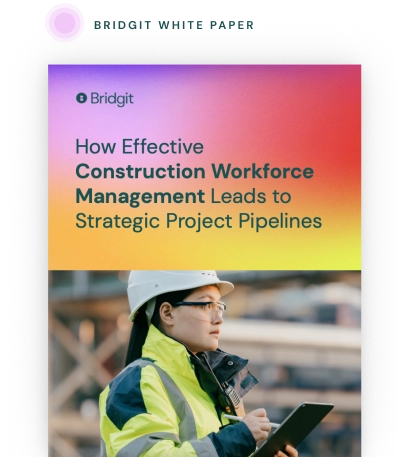The issue of rising interest rates has home builders concerned about inflation, higher building costs, and challenges to the economy, which are expected to last for the next few years. The Consumer Price Index (CPI), the broadest measure of inflation, shows an increase of 6.4% over the last 12 months.
Table of Contents
While the inflation rate is less than the record-setting percentage a few months ago, it’s still high and the Federal Reserve has continued lifting interest rates to curb it. This has major effects on the construction industry because loans are often needed to complete projects since having millions of dollars in cash is not always feasible.
Here are some construction industry challenges that have been caused by rising interest rates and how may they affect the construction workforce.
Supply chain issues and increased costs for building material
Although interest rate increases can help with controlling inflation to a certain extent, it can exacerbate supply chain issues, driving up prices for building materials. Higher interest rates mean that overall, construction projects will become more expensive, particularly affecting the building material market.
Rising construction costs have resulted in an increase in pricing for materials like lumber, steel, concrete, and oriented strand boards (OSB), beginning during the pandemic and continuing to this day.
Data from the Bureau of Labor Statistics point to an increase in building material prices by 20% year-over-year—that’s 31% more than January 2020.
Add to that the limited availability of various building products, which haven’t been able to keep up with demand. Along with rising construction material costs, builders waiting for longer periods of time for materials to be delivered have caused a record number of new homes under construction to be delayed and remain pending.
To combat increased costs due to higher interest rates, construction firms will have to adjust their project pricing and realign their resources accordingly.
This may mean firms take on less work in order to keep costs down, which results in layoffs, either permanently or temporarily. For an industry already facing labor shortages, layoffs are the antithesis of a solution to the problem.

Use your workforce data to create a competitive advantage
Download our white paper to see how effective workforce planning can help stay ahead of labor demands and create a strategic project pipeline.
More expensive loans and difficulty securing funding
It’s not uncommon for companies to borrow when interest rates are low to invest and increase profitability, earning the money back on projects to pay off the loan and turn a profit. Rising construction costs due to higher interest rates mean loans will be more expensive.
While smaller businesses with fixed-rate loans will be impacted less, company owners that take out loans with fluctuating interest rates may have greater difficulty repaying them. This can discourage companies from taking out loans as it makes it harder to secure funding, ultimately lowering profit margins.
One of the largest expenses for contractors is paying its workforce. Without the funds to pay its workers, businesses will have to reconsider where they’re directing their project resources. This could involve moving away from investment and innovation that make business operations more efficient in order to stay afloat.
Essentially with harder access to funds, contractors are left to make starker tradeoffs for what’ll make their business successful.
The possibility of stagnant industry growth
Housing
Home construction costs rising means that companies will be less likely to expand and invest, slowing down industry and company growth due to a lack of available funding.
There’s also the concern of higher mortgage rates possibly impacting the demand for new housing. Rising housing costs are already a major problem for would-be buyers—interest rate hikes are likely to knock potential buyers out of the market completely.
Future sales are expected to drop further, with declines creating concern for decreased demand, which could significantly impact the construction industry. For now, though, this remains an issue to be further surveyed.
The level of housing demand, affected by mortgage and interest rates, will be a great factor in the construction industry’s future growth.
Infrastructure
One of the scarier prospects caused by inflation and the subsequent rising interest rates is that the money from the IIJA could be drained into the extra cost of projects. Companies throughout the country were counting on a bump in their budgets from the legislation, but the rising inflation has dampened the parade.
Additionally, contractors are having difficulty bidding on projects because they can’t get commitment from suppliers, making it harder to properly budget and plan for projects.
Project sponsors are also not seeing the robust competition that they thought they would because of the hesitancy for contractors to bid on projects. When they do get bids, they’re coming in with a high price, making it difficult to get the most out of federal money.
There will be a major ripple effect with the IIJA money being sapped. One of those effects is the number of jobs that were supposed to come from these funds just won’t be there in the numbers expected. Another effect is states won’t be able to replenish and revive their infrastructure to support their populations over a long period of time.
Combat rising interest rates with Bridgit Bench
To keep up with rising construction costs and interest rates, you’ll need a way to efficiently manage your resources and optimize your workforce utilization. One of the best ways of doing so is by modernizing your workforce management process with Bridgit Bench, a solution that allows you to track project progress and manage construction personnel.
Construction Interest Rates FAQ
Are construction loan rates higher than mortgage rates?
Yes, construction loan rates are usually higher than conventional mortgages because construction loans carry more risk due to project considerations. Lenders will charge high rates to offset potential issues such as cost overruns, project delays, or other unforeseen circumstances.
Why are construction loans so expensive?
Construction loans are expensive due to higher risks, such as project completion uncertainties, cost overruns, and market fluctuations. Lenders mitigate these risks by charging higher interest rates and fees, ensuring they are compensated for the potential financial exposure.
How much interest is on a construction loan?
Interest rates on construction loans typically range from 4% to 12%, depending on the borrower’s creditworthiness, the lender’s terms, and the current market conditions. Rates can vary significantly, so it’s important for you to shop around for the best terms.
What is the interest rate for construction loans in 2024?
As of early 2024, construction loan interest rates generally range from 5% to 9%. Rates can vary based on economic conditions, the borrower’s credit profile, and specific lender terms. It’s advisable to check with lenders for the most current rates.
Think your workforce planning meetings could be more productive?
Download our ebook to learn how to run efficient, effective workforce planning meetings with your team.
Our tool allows you to plan your workforce strategically, grow and retain your top talent, and realize the full potential of your employees while leveraging historical project data and making informed bidding decisions.
As we see the effects of rising interest rates and inflation seep into the industry, it’s vital that you’re using your workforce effectively since your people are your most important asset.



